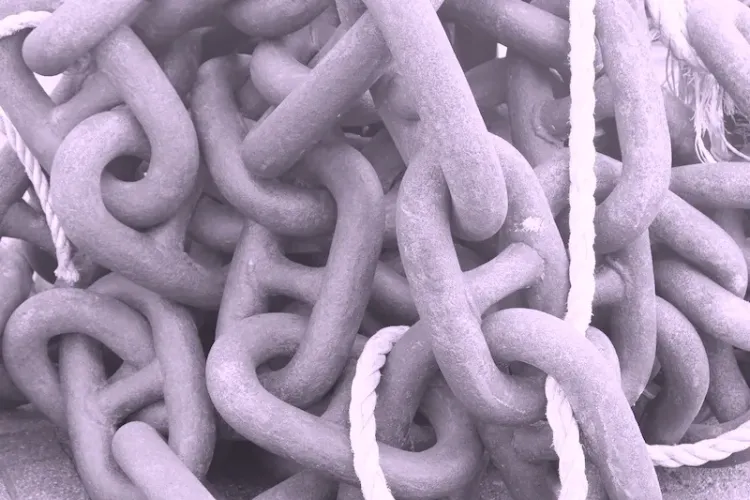Bulletin March 30 2018. Translating for Geeks Since 1987
I was looking at some stuff about neural networks the other day. There’s two implementations, apparently: one which looks something like a tree-walk algorithm, and the other, more like a fishing net with various knots. I can’t remember exactly what the differences were, but suffice to say that one is better at some things than the other.
Which is important, of course, but not for the purposes of this discussion. More relevant is that the fishing net approach reminded me of something I saw (potentially being invented, I can’t remember) pretty early on in my career. It was known as Layout Interlace Field, and its creator was one Tim Bolton.
Back in the day I was a Pascal programmer for Philips Components, and we were writing software for silicon chip design. The place was delightfully well run, a fact I only found out when I left. I remember reading Tom De Marco and Timothy Lister’s seminal book, Peopleware, and thinking, “Who’d be so dumb as to not apply all that best practice!” The answer, it turned out, was most other organisations…
I digress. The thing about chip design is that you are always looking to squeeze as many bits of circuit onto the wafer as you can — Moore’s Law can only get you so far. The exceedingly bright Tim came up with an idea: how about creating vertical and horizontal lines of silicon down the chip, then only connecting the points at which you wanted a transistor to be (like a knot on a fishing net)?
I can’t remember the detail, and right now it does sound similar to a programmable logic array, but it did make for much denser designs. Indeed, it is highly likely that it’s the kind of thing being done in today’s neural-network-optimised chips. Another digression but I must take a look some time. More important was, Tim was the kind of person (and probably still is) that would do things very differently, with all the benefits that brings.
At the same time however, he wasn’t the world’s best communicator of what he created. One of my earliest tasks was to write some documentation for the compaction software Tim had written (Moore’s Law can only get you so far, yadda yadda). I simply had to interview Tim and write down what he told me.
The software was pretty smart, as you’d expect. When you lay out a circuit in a CAD system, you essentially create a series of rules — this track connects to that track, those two elements need to stay so far apart, and so on. Tim’s algorithm loaded all of these rules into a giant (for the time) matrix, did all they could to squeeze everything down to the bottom left corner, and then (the really clever bit) flipped the matrix like you might a tablecloth, then squeezed it all down into the bottom left again.
Of course, sometimes the rules were already pretty tight and left little room for any squeezing. So the software also employed a soupçon of simulated annealing, that is, loosen everything up a bit (like when you heat a metal) and then apply the compaction when it is ‘cooling’. Simples.
Of course, Tim didn’t explain it to me like that. Rather, he told me about each low-level instruction, it’s purpose and capability. It was only after sitting with him going through the code (what felt like) line by line over a period of (what felt like) weeks before I had the sudden epiphany about what the code actually did.
Which is pretty much what I still do today. I remain in absolute awe about the engineers and innovators that are creating our shared future in front of our eyes: their engineering talent does not always leave room for more down-to-earth skills, and I am truly grateful for that as well. The day that technology becomes straightforward to understand, I understand, I will be out of a job.
For the time being however, I think I should be OK… with this in mind, here’s a couple of articles for the week.
Is enhanced reality an AR/VR cop-out?
I heard a new term this week, and wanted at least to mark its existence. Indeed, I could have written a whole newsletter about the notion of making things a little better than before, rather than setting out to change the world (or should I say re-imagining? As an aside, I bloody love Indiegogo with its barking mad campaigns, it has replaced Skymall in my mind)…
Digital Transformation 101: What are we trying to transform, and why?
Okay, this may be old news but it only recently occurred to me that the reason consultants love cloud is because they love outsourcing, and cloud is a form of outsourcing… oh, wait… meanwhile the napkin sketch has been likened to various sausage-like objects. Answer on a postcard.
Heads-up: TechPitch
I hope the above treatise illustrates my genuine delight to be involved as a judge on the TechPitch 4.5 panel in April. Startups get a 3-minute opportunity to pitch their idea to attendees, we score them and then the audience also get a vote. I couldn't help noting that one of the startups was intriguingly called Dadshed, so it is wholly appropriate I am there; beer may also be involved. Tickets available here.
In other news, Big Big Bread
Those who know me also know my absolute passion, and obsession for baking bread. Passion, because it is possibly one of the first things we ever learned to cook (unless you count turning a small rodent over a fire); obsession, because… I don’t know. But I do now have a small flour mill. Obsessions seem to happen to me rather than me having any choice in the matter (in this case, it was a day-long course with the amazing bread maker). I also have a penchant for beer (my attempts at fermenting have never been as successful, to my shame) and progressive rock music… so here’s a recipefor bread made with beer from one of my favourite bands. Enjoy.
Don't tell but I wrote most of this on a plane to Jakarta, from where I am now sending it. Next week's bulletin will summarise everything I've written over the past three months, scheduled in advance so I can sit on a beach with a cocktail and not worry about it (to whit, someone once said to me, "Of all the things to do on a beach in Nice, you're writing a report." "Of all the places to write a report..." I replied.
Until next time, Jon


